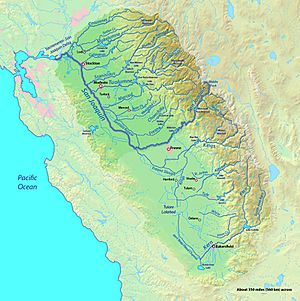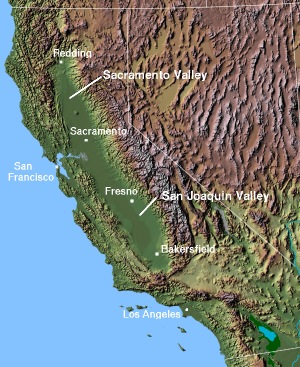Lake Corcoran facts for kids
Lake Corcoran was a huge ancient lake that once covered a big part of California's Central Valley. It's also sometimes called Lake Clyde, named after Clyde Wahrhaftig, a smart American scientist who studied the Earth.
This giant lake stretched across the valleys of the Sacramento River and the San Joaquin River. Some scientists think it only covered the southern parts of the Central Valley. Either way, it was enormous! The lake covered an area of about 30,000 to 50,000 square kilometers (that's like 11,500 to 19,000 square miles). Today, smaller lakes like Buena Vista Lake, Kern Lake, and Tulare Lake are what's left of Lake Corcoran.
What Was Lake Corcoran Like?
Lake Corcoran was the source of something called the Corcoran Clay. This clay is a special type of rock layer that formed at the bottom of the lake. Scientists find this clay in other rock layers, like the Tulare and Turlock Lake formations. The lake also affected how sand and mud settled along the California coast.
When Did Lake Corcoran Exist?
Lake Corcoran existed a very long time ago, roughly between 758,000 and 665,000 years ago. Scientists believe the lake lasted for about 50,000 to 100,000 years. During this time, ash from huge volcanic eruptions, like the Lava Creek Tuff from Yellowstone Caldera and the Bishop Tuff from the Long Valley Caldera, settled into the Corcoran Clay.
Before Lake Corcoran formed, the Central Valley was actually a bay connected to the ocean. About 2 million years ago, the Coast Ranges (a mountain range) moved northwest along the San Andreas Fault. This movement closed off the bay from the ocean. After that, the valley was no longer a bay. Instead, it would sometimes fill with water and sometimes drain. Scientists are still trying to fully understand all the reasons why Lake Corcoran formed.
How Did the Lake Drain?
Originally, Lake Corcoran's water flowed out into Monterey Bay through the Salinas River. Sometimes, the lake didn't drain at all. Water evaporating from this huge lake helped create rain and snow for the Sierra Nevada mountains. It also provided some water for the Basin and Range Province behind the Sierras. This extra water helped form many large ancient lakes in Nevada.
About 600,000 years ago, a new way for the lake to drain opened up. This new outlet is where the San Francisco Bay is today. Evidence shows that by 400,000 years ago, this new drainage system was fully working.
Scientists think this overflow might have happened when glaciers were melting. Also, changes in the jet stream (strong winds high in the atmosphere) during a cold period called marine oxygen isotope stage 6 could have caused more rain and runoff into the Central Valley. This huge overflow quickly carved a path through the Carquinez Strait, probably very suddenly. This event drained the massive lake. Sediments from the former lake were then carried out through this new outlet and down to Monterey Bay by ocean currents.



